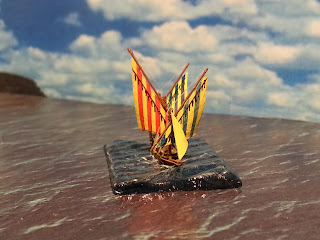History:
The ship was named after the renowned French privateer M. Rene' Duguay-Trouin (1673-1736). The ship was designed by Jacques Noel Sane and launched at Rochefort in 1800. This ship that fought at Trafalgar should not be confused with the 74-gun Duguay Trouin that was launched in 1789. That ship was burned along with nine other vessels under Admiral Hood's orders when Toulon was evacuated in 1793.
Duguay Trouin put to sea out of Cadiz with the combined fleet on October 19, 1805. Initially she sailed in the rear division commanded by Rear Admiral Dumanoir. When the combined fleet turned north, reversing it's sailing order at 8 PM on October 21, Duguay Trouin lay fifth in line from the head of Villeneuve's fleet. Ahead lay Dumanoir's flagship Formidable (80), astern Mont Blanc, and to leeward the frigate Cornelie (40). Once the battle opened, Dumanoir's division of 10 ships became isolated from the ships brought to action by Nelson's division.With little wind to tack, six of his ships, Neptune, Scipion, Rayo, Formidable, Duguay Trouin, and Mont Blanc were unable to return and support Villeneuve's center. Some used their boats to get the ships turned back through the wind, so Dumanoir's ships eventually re-entered the battle. Duguay Trouin, following Formidable, came under raking fire from Minotaur (74) and Spartiate (74). By 4:30 PM Formidable, followed by Duguay Trouin, Mont Blanc, and Scipion sailed south of the battle, leaving the Spanish Neptuno closely engaged with Minotaur and Spartiate.
Sailing in company with Formidable, Mont Blanc and Scipion, Duguay Trouin was spotted by Phoenix (36), Captain Thomas Baker off Cape Finisterre on November 2. Baker informed Captain Sir Richard Strachan who was laying off Ferrol with his squadron of eight ships. The squadron consisted of the following ships: Caesar (80), Bellona (74), Couragious (74), Hero (74), Namur (74), Revolutionnaire (38), Santa Margarita (36), and AEolus (32). Joined by Phoenix (36), Strachan, flying his pendant in Caesar, set off in pursuit. The next afternoon Bellona, a poor sailer, parted company. By the morning of November 4 the squadron had closed to within six miles of Dumanoir's squadron. At around 11:45 AM Caesar, Courageous, and Hero formed line ahead and began running down upon the four French ships. Following orders, Duguay Trouin took in her small sails and hauled up on a starboard tack, heading NE then formed line ahead, followed in order by Formidable, Mont Blanc, and Scipion. Signalling to Gardener in Hero that he intended to attack the center and rear of the French line, Strachen's ships commenced action at 12:15 PM, coming up on Dumanoir's windward side and opening fire from their larboard guns. At around 12:55 PM when Duguay Trouin luffed to cross and rake Caesar's bow, Strachan's ship counter-maneuvered by doing likewise. In her attempt to tack, Duguay Trouin unfortunately missed stays and losing way, for a short time came under considerable fire from Caesar and Hero. The action eased and when the French ships came onto a port tack at 1:20 PM the British gave chase. With Namur joining at 2:00 PM, battle was resumed and by 3:15 PM Formidable and Scipion had struck. Meanwhile Duguay Trouin and Mont Blanc attempted their escape but were soon overhauled by Caesar and Hero. After 20-minutes' close action both ships simultaneously struck at 3:35 PM. Total French casualties amounted to 750 killed and wounded; among her dead was Claude Touffet, Duguay Trouin's captain. British casualties were 14.8 per cent of the French. All four French ships were taken into Plymouth on November 10. Appropriately renamed Implacable and entered into the Royal Navy, the ship was laid up in the Hamoaz until 1807.
(Paraphrased from "The Ships of Trafalgar - The British, French and Spanish Fleets October 1805" by Peter Goodwin)
Stats: Length of gun deck - 181'6"; Breadth - 48'11"; Depth in hold - 22'; Tons burthen 1896.22; Complement - 670
Armament: Single broadside weight - 854 pounds, (later - 966 pounds);
Lower gun deck - 28 x 36 pounders (later 32 pounders)
Upper gun deck - 30 x 18 pounders
Quarter deck - 14 x 8 pounders (later 2 x 12 pounders & 12 x 32 pdr carronades)
Forecastle - 6 x 8 pounders (later 2 x 12 pounders & 2 x 32 pdr carronades)
 |
| Comparison - GHQ 74 (231) on the left |
 |
| Comparison - Langton 74 (NS-22) on the left |


















































